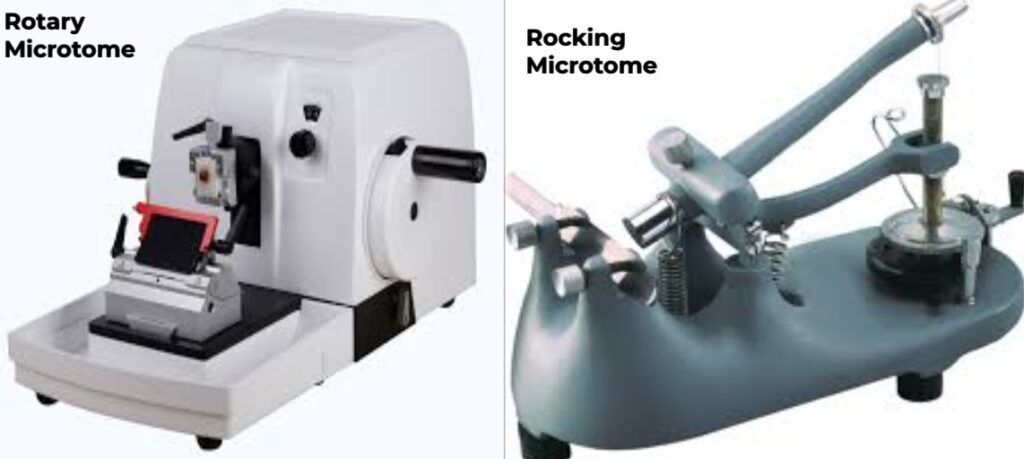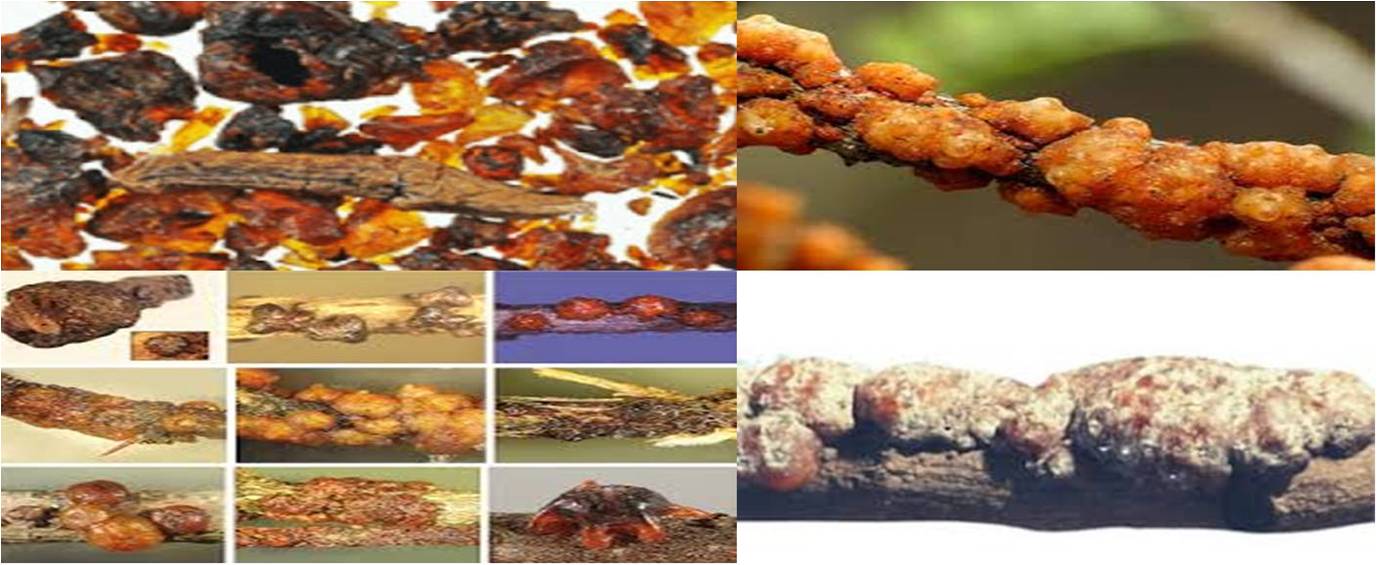Rotary and Rocking Microtome: Microtomes are essential tools in the field of histology, allowing to thin tissue sections for microscopic analysis.
Most commonly used microtome are the rotary and rocking microtomes. Understanding their uses, handling methods, and precautions is crucial for producing accurate results in both medical and scientific research.
Rotary and Rocking Microtome
Rotary Microtome:
- The rotary microtome is a mechanical instrument designed to cut extremely thin slices of biological samples.
- Commonly used in medical and research laboratories, it allows for the preparation of paraffin-embedded tissue sections with remarkable accuracy.
- It operates with a staged rotary action such that the actual cutting is part of the rotary motion.
- In a rotary microtome, the knife is typically fixed in a horizontal position.
A rotary action of the hand wheel actuate the cutting movement. - Hard tissues can be cut without vibration. Serial sections or ribbons of sections can easily be obtained.
- The block holder or block (depends upon the type of cassette) is mounted on the steel carriage that moves up and down and is advanced by a micrometer screw.
- Auto-cut microtome has built in motor drive with foot and hand control.
- With suitable accessories the machine can cut thin sections of paraffin wax blocks and 0.5 to 2.0 micrometer thin resin sections.
Advantages
- The machine is heavy, so it is stable and does not vibrate during cutting.
- Serial sections can be obtained.
- Cutting angle and knife angle can be adjusted.
- It may also be used for cutting celloidin embedded sections with the help
of special holder to set the knife.

Rocking Microtome:
- The rocking microtome, developed in the 19th century, was one of the earliest devices for slicing biological tissue.
- Rocking microtomes are still utilized in educational settings due to their simplicity and cost-effectiveness.
- A rocking microtome is used to slice soft, wax-embedded tissues for microscopic examination.
- A rocking microtome can section specimens up to 20 mm in diameter.
- A rocking microtome can vibrate while cutting because it’s lighter.
- A rocking microtome is suitable for cutting small, soft objects but can’t cut hard materials like wood or bone.
- The specimen moves in an arc across the fixed razor in a rocking motion.
- A rocking microtome uses an A-type biconcave razor knife that’s easy to sharpen but can quickly become blunt.
- A rocking microtome can cut sections that are 2–24 microns thick in 2 micron increments.
- The rocking microtome has largely been replaced by the more precise rotary microtome
Key Differences Between Rotary and Rocking Microtomes
| Feature | Rotary Microtome | Rocking Microtome |
| Precision | Extremely high (1-10 µm) | Moderate (thicker sections) |
| Ease of Use | Requires more training | Simpler operation |
| Application | Research, clinical settings | Teaching, educational purposes |
| Cost | Higher | More affordable |
Precautions for Using Microtomes
Handling microtomes requires adherence to strict safety protocols to avoid accidents and ensure quality results.
- Operators should always wear personal protective equipment (PPE), including gloves and lab coats. ‘Rotary and Rocking Microtome’
- The microtome blades are extremely sharp, and improper handling can result in serious injury.
- Regular cleaning and calibration are maintaining the efficiency of a microtome.
- To achieve the best results with either rotary or rocking microtomes, operators should follow specific guidelines.
- Keeping the sample block at the correct temperature, ensuring the blade is sharp, and using the correct cutting speed all contribute to obtaining high-quality sections.
Microtome Knife
- It is the important instrument used to cut uniform thin serial sections of the tissue.
- For routine purpose wedge (C type) knife is used. It is plain on both sides. The size varies from 100 mm to 350 mm in length.
- Microtome knives are made of good quality of high carbon or steel which is tempered at the tip.
- Hardness of knife is essential to obtain good tissue sections.
- To achieve good sections knife should be very sharp.
- The knife is put in the knife back to sharpen. Knife can be sharpened manually or by the use of automatic machine. ‘Rotary and Rocking Microtome’
- Honing – This is done to remove nicks and irregularity from the knife edge.
- Coarse and fine honing is done using different abrasives.
- The purpose of stropping is to remove the “burr” formed during honing and to polish cutting edge. ‘Rotary and Rocking Microtome’
- Other types of knives are diamond and glass knives. These knives are very expensive and used for ultramicrotomy.
- Disposable knife – Nowadays these microtome blades are used. Two types of disposable blades are available.
- Low profile blade – Usually used for cutting small and soft biopsies like
kidney and liver biopsies. - High profile blade-Used for any tissue like myometrium, breast tumor or
skin.
Advantages
- Time is not spent in sharpening, honing or stropping the knife.
- Resistant to both corrosion and heat.
- Hardness of blade can be compared with the steel knife.
Disadvantages
- Relatively expensive
- Disposable blades are not as rigid as steel knife:
Care of the Microtome Knife
- Store the knife in its box, when not in use.
- The knife should be cleaned with xylene before and after use.
- When knife is being stored for a long time, it should be smeared with grease
or good grade of light oil. - Knife edge should not be touched.
- Knife edge should never be come badly nicked. It is advisable to use separate knife for cutting hard issue like bone.
- The above points are important if re usable knife is being used.
Frequently Asked Questions (FAQs)
- What is the difference between rotary and rocking microtomes? Rotary microtomes offer higher precision for cutting thinner sections, while rocking microtomes are more affordable and suitable for educational purposes.
- How should I maintain my microtome? Regular cleaning, blade sharpening, and calibration are essential for the long-term performance of a microtome.
- What precautions should be taken when using a microtome? Always wear protective gear and handle blades with care to avoid injury.
- Can I use a rocking microtome for research purposes? While possible, rotary microtomes are more suitable for research due to their higher precision.
- How thin can rotary microtomes cut sections? Rotary microtomes can produce sections as thin as 1 micrometer, ideal for detailed tissue analysis.
- Why are rotary microtomes preferred in medical labs? Their ability to produce consistent and ultra-thin sections makes them essential in diagnostic histology.





